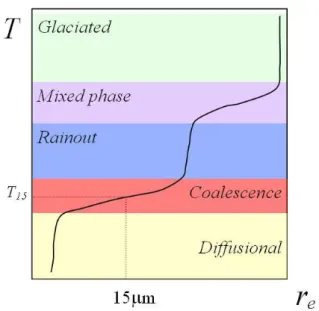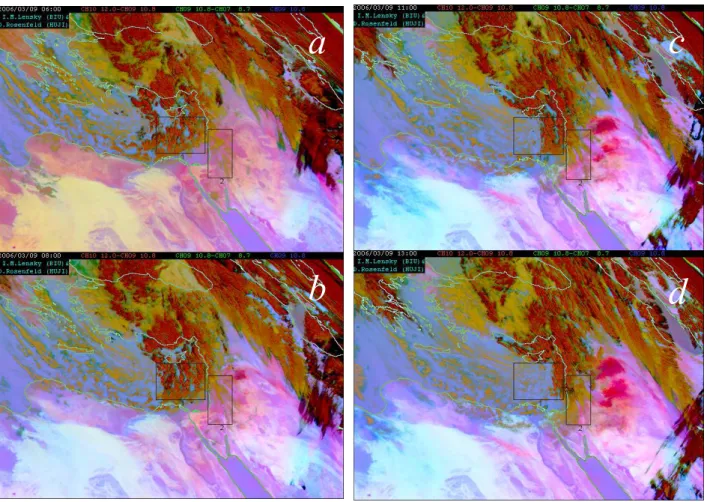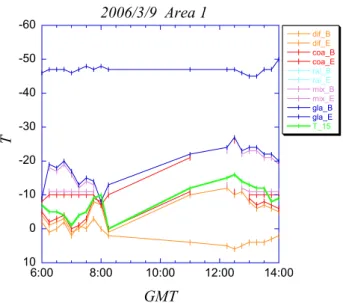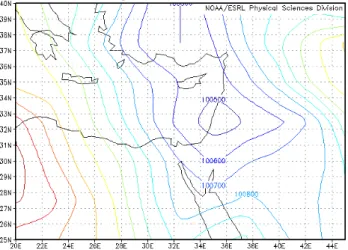HAL Id: hal-00297029
https://hal.archives-ouvertes.fr/hal-00297029
Submitted on 13 Aug 2007
HAL is a multi-disciplinary open access
archive for the deposit and dissemination of
sci-entific research documents, whether they are
pub-lished or not. The documents may come from
teaching and research institutions in France or
abroad, or from public or private research centers.
L’archive ouverte pluridisciplinaire HAL, est
destinée au dépôt et à la diffusion de documents
scientifiques de niveau recherche, publiés ou non,
émanant des établissements d’enseignement et de
recherche français ou étrangers, des laboratoires
publics ou privés.
Using MSG to monitor the evolution of severe
convective storms over East Mediterranean Sea and
Israel, and its response to aerosol loading
I. M. Lensky, S. Shiff
To cite this version:
I. M. Lensky, S. Shiff. Using MSG to monitor the evolution of severe convective storms over East
Mediterranean Sea and Israel, and its response to aerosol loading. Advances in Geosciences, European
Geosciences Union, 2007, 12, pp.95-100. �hal-00297029�
© Author(s) 2007. This work is licensed under a Creative Commons License.
Geosciences
Using MSG to monitor the evolution of severe convective storms
over East Mediterranean Sea and Israel, and its response to
aerosol loading
I. M. Lensky and S. Shiff
Department of Geography and Environment, Bar-Ilan University, Ramt-Gan, Israel
Received: 2 March 2007 – Revised: 30 July 2007 – Accepted: 6 August 2007 – Published: 13 August 2007
Abstract. Convective storms over East Mediterranean sea
and Israel were tracked by METEOSAT Second Generation (MSG). The MSG data was used to retrieve time series of the precipitation formation processes in the clouds, the temper-ature of onset of precipitation, and an indication to aerosol loading over the sea. Strong correlation was found between the aerosol loading and the depth above cloud base required for the initialization of effective precipitation processes (in-dicated by the effective radius = 15 µm threshold). It seems from the data presented here that the clouds’ response to the aerosol loading is very short.
1 Introduction
In March and April 2006, toward the end of the rain sea-son in Israel, few very severe rain events occurred. Some of the events were accompanied with dust (9 March , 4 April), other produced floods (2 April) and even one tornado was recorded (4 April). These events will be analyzed here using a technique that Rosenfeld and Lensky introduced in 1998. In the Rosenfeld Lensky technique (RLT), vertical profiles of the cloud particles’ effective radius (re)are analyzed to
gain insights into precipitation forming processes. Rosen-feld and Lensky (1998) used Advanced Very High Resolu-tion Radiometer (AVHRR) data on the polar orbiting NOAA satellites for their study. Later the RLT was applied to other sensors on polar orbiting satellites (VIRS on TRMM, GLI on ADEOS II, MODIS on Terra and Aqua), and was used in many studies to assess the impact of different aerosols on clouds and precipitation. (Rosenfeld, 1999, 2000; Rosen-feld et al., 2001, 2002, 2004; RosenRosen-feld and Woodley, 2001, 2003; Ramanathan et al., 2001; Rudich et al., 2002, 2003;
Correspondence to: I. M. Lensky
(lenskyi@mail.biu.ac.il)
Tupper et al., 2004; Williams et al., 2002; Woodley et al., 2000).
Lensky and Drori (2007) followed the RLT approach and defined the temperature of onset of precipitation (T15), as
the temperature where the median reexceeds a precipitation
threshold of 15 µm (Lensky and Rosenfeld, 1997), and D15
as the temperature difference (depth) between T15 and the
cloud base temperature (Tbase).
In this paper we use data from the European geostationary satellite METEOSAT Second Generation (MSG) to retrieve time series of the RLT microphysical zones, D15, and an
in-dication to the aerosol loading over the sea.
In the next section the methodology of the cloud character-ization will be described, followed by the case studies. Sum-mary and conclusions will close this paper.
2 Methodology
The retrieval of precipitation formation processes is done by using microphysical zones from the RLT. The RLT uses re
and cloud top temperature (T ) of all the cloudy pixels in a predefined area as input. One of the outputs of the RLT is the highest and lowest temperatures of the following five mi-crophysical zones: the diffusional growth zone, coalescence growth zone, rain out zone, mixed phase zone and glaciated zone. These microphysical zones and T15 are schematically
shown in Fig. 1.
The RLT is based on two assumptions:
(a) The evolution of rewith height (or T ), observed by the
satellite at a given time (snapshot), for a cloud ensem-ble over an area, is similar to the T −retime evolution
of a given cloud at one location. This assumption of exchangeability between the time and space domains is called the ergodicity assumption (see Fig. 2a).
96 I. M. Lensky and S. Shiff: Using MSG to monitor the evolution of severe convective storms
Fig. 1. Schematic representation of the five microphysical zones: diffusional, coalescence, rain out, mix phase and glaciated; and the temperature of onset of precipitation (T15).
Fig. 2. Schematic representation of the two assumptions underlying the RLT. (a) the ergodicity assumption (exchangeability between the time and space domains) says that the T −reobserved by the
satellite at a given time (t0)for a cloud ensemble (C1C2C3)over an area, is similar to the time evolution (t1t2t3)of the T −reof a given
cloud (C0), at one location. (b) the re near cloud top is similar to
that well within the cloud at the same height as long as precipitation does not fall through that cloud volume.
(b) The re near cloud top (T1) of one cloud in a cloud
cluster, is similar to the re of any other cloud in the
same cloud cluster, at the same height (where T1is well
within the other clouds) as long as precipitation does not fall through that cloud volume (see Fig. 2b), and that all the clouds in the cloud cluster, are in the same environment in terms of the ambient air’s dynamic, ther-modynamic and aerosol loading. Different clouds in this cloud cluster should have more or less the same CCN. This assumption may brake in the vicinity of a point source of aerosols such as power plant (Rosen-feld, 2000), or if the analyzed area is too large. In that case a more careful treatment of the T −re plot will be
needed (i.e. the use of different percentiles of the refor
different clouds).
Fig. 3. Sea level pressure (in Pascal) for 9 March 2006, 06:00 GMT, based on the NCEP-NCAR CDAS-1 archive (Kalnay et al., 1996; Kistler et al., 2001).
The second assumption was verified using in situ aircraft measurements (Rosenfeld and Lensky, 1998; Freud et al., 2005). To address the ergodicity assumption, Lensky and Rosenfeld (2006) used rapid scan data (three minutes in-terval) of the Spinning Enhanced Visible and InfraRed Im-ager (SEVIRI) on board the MSG satellite (Schmetz et al., 2002). One outcome of that study was a tool named CAP-SAT: Clouds, Aerosols, and Precipitation Satellite Analysis Tool (Lensky and Rosenfeld, 20071). In this paper we used CAPSAT to analyze the MSG data. In each area and time step (see Sect. 3) we looked for the five microphysical zones defined in the RLT, and T15. As an indication for the aerosol
loading over the sea we looked for the smallest cloud free visible (0.6 µm) reflectance in area 1.
3 The case studies
In this study we use MSG SEVIRI data. Fifteen minutes interval data, from 06:00 to 14:00 GMT from three cases of sever weather in 2006: 9 March, 2 April and 4 April were used to monitor convective clouds over East Mediterranean Sea (area 1) and Israel (area 2).
In the first case study from 9 March 2006, a highly de-veloped large scale cyclonic system approached Israel in the early morning (see Fig. 3), with a dust storm developing over South East Mediterranean. Figure 4 shows clouds and dust interacting in areas 1 and 2 at 06:00 GMT (a); 08:00 GMT (b); 11:00 GMT (c); and 13:00 GMT (d). In this color scheme, clouds are colored in orange and red, and dust is colored in pink. Strong dust storm is developing in the north-east corner of area 2 in panel b, and intensifies in panels c and
1Lensky, I. M. and Rosenfeld, D.: Clouds-Aerosols-Precipitation Satellite Analysis Tool (CAPSAT), Atmos. Chem. Phys. Discuss., to be submitted, 2007.
a
b
c
d
Figure 4. Clouds and dust over East Mediterranean Sea (area 1) and Israel (area 2). Panel a is from March 9 2006 6:00 GMT, b 8:00 GMT, c 11:00 GMT, and d 13:00 GMT. In this color
Fig. 4. Clouds and dust over East Mediterranean Sea (area 1) and Israel (area 2). Panel (a) is from 9 March 2006, 06:00 GMT, (b) 08:00 GMT, (c) 11:00 GMT, and (d) 13:00 GMT. In this color scheme clouds are colored in orange and red, and the dust in pink.
d. Dust is actually seen over the eastern part of the delta of the Nile in panel a moving eastward over southeast Mediter-ranean sea and to the southern part of area 2 in panel b. From this figure one can see that there is much more dust in area 2 than in area 1. Indeed, the time series of the temperatures: Tbase, T15 and the cloud top temperatures (Ttop)in areas 1
and 2 in Fig. 5 show that the D15 parameter is much larger
in area 2 than in area 1, indicating that the clouds that were exposed to the dust (in area 2) are more continental (smaller re, larger diffusional growth zones, and larger D15). Figure 6
shows time series of the temperature of the base and top of the RLT zones: diffusion (orange), coalescence (red), mixed phase (purple) and glaciated (blue), and the temperature of onset of precipitation (T15 – in green) for the same data as
in area 1 of this case study. Note that onset of precipitation (T15)is reached only after coalescence (or mixed phase) are
initiated.
The pink colors in Fig. 4 can give a qualitative indication to the existence of dust. A more refined quantitative parame-ter of the aerosol loading was checked here. The reflectance of sea water in the visible channel (0.6 µm) in Clear sky
con--60 -50 -40 -30 -20 -10 0 10 20 6:00 8:00 10:00 12:00 2006/03/09 Area 1 T GMT D15 8:00 10:00 12:00 Area 2 Ttop T15 Tbase GMT D 15
Figure 5. Time series of the cloud base temperature (T ), the temperature of onset of
Fig. 5. Time series of the cloud base temperature (Tbase), the tem-perature of onset of precipitation (T15), and cloud top temperature (Ttop), of the clouds in Fig. 4. D15 is the temperature difference (depth) between T15and Tbase.
ditions (aer) is very low (3.5–4%) and uniform. Over this dark uniform background, any addition of aerosol loading will result in higher visible reflectance. We assume that the
98 I. M. Lensky and S. Shiff: Using MSG to monitor the evolution of severe convective storms -60 -50 -40 -30 -20 -10 0 10 6:00 8:00 10:00 12:00 14:00 2006/3/9 Area 1 dif_B dif_E coa_B coa_E rai_B rai_E mix_B mix_E gla_B gla_E T_15 T GMT
Fig. 6. Time series of the temperature of the base and top of the RLT zones: diffusion (orange), coalescence (red), mixed phase (purple) and glaciated (blue), and the temperature of onset of precipitation (T15)(green) for the same data as in area 1 of Fig. 5. T15is reached only after coalescence (or mixed phase) is initiated.
0 5 10 15 20 25 3 4 5 6 7 8 9 6:00 8:00 10:00 12:00 14:00
2006/3/9 Area 1
D
15[
oC]
Mi
n v
is
ibl
e r
ef
le
ct
anc
e [
%
]
GMT
μ Fig. 7. Time series of D15 and the minimal visible (0.6 µm) flectance for the same data as figure 6. The minimal visible re-flectance is used here as a quantitative measure for aerosol loading, and shown here to be highly correlated to D15. Also notable is the clouds’ response to the aerosol loading.cloud free minimum visible reflectance in area 1 is correlated with aerosol loading. Figure 7 shows time series of D15and aer in area 1. These two parameters are highly correlated.
Also notable is the quick response of the cloud microphysics to the aerosol loading: in most of the curve it is shorter than the 15 min interval of the MSG data.
Fig. 8. As Fig. 3, but for 2 April 2006, 12:00 GMT.
Figure 9. T-r plot of Area 1 April 2nd, 2006, 10:45 GMT; the number of pixels (in blue) in
μ
Fig. 9. T −replot of Area 1, 2 April 2006, 10:45 GMT; the number
of pixels (in blue) in each 1◦C temperature interval, and the
mi-crophysical zones, showing deep diffusional growth zone (∼20◦C)
with re<10 µm, followed by mixed phase zone with probably
co-alescence (∼20◦C) and glaciation zone (∼22◦C). Heavy rains
oc-curred in Wadi Ara region in the northern part of Israel, resulting with severe floods, and record high rain intensity and duration. D15 shows extremely continental values of ∼25◦C, as those of clouds in
heavy smoke (Lensky and Drori, 2007).
In the second case study of 2 April heavy rains occurred in the Wadi Ara region in the northern part of Israel, resulting with severe floods, and record–high rain intensity and dura-tion. Figure 8 shows the Sea level pressure (in Pascal) of 12:00 GMT of this case study. Figure 9 shows T −re plot
of Area 2 of this case study, from 10:45 GMT, and the mi-crophysical zones, showing a deep diffusional growth zone (∼20◦C) with r
e<10 µm, followed by a mixed phase zone
(∼20◦C). As the slope of the T −r
ecurve in both coalescence
and mixed phase growth may be the same, the RLT takes an arbitrary temperature of −10◦C, as the limit between these
Fig. 10. As Fig. 3, but for 4 April 2006, 12:00 GMT.
two microphysical growth zones. To get a more reliable pic-ture on which of the processes actually exists in that tempera-ture interval in the analyzed area, a spectral analysis on pixel basis (the pixels in that temperature interval) should be car-ried out. This can be done for example by looking at the ratio between the reflectance in 0.6 and 1.6 µm where the larger values will indicate the existence of ice. A glaciation zone of about 22◦C followed the mixed phase zone. D
15 shows
ex-tremely continental values of about 25◦C, similar to clouds
in heavy smoke (Lensky and Drori, 2007).
In the third case study a quickly deepening upper trough formed a surface low over South East Mediterranean during the night between 3 and 4 April. The upper air system con-tinued to develop forming a low over Cyprus on the noon of 4 April, creating an extremely unstable atmosphere over Israel and allowing the development of a super cell in the north. Figure 8 shows the T −re plot of the data extracted
from area 2 on 4 April, 13:00 GMT. The microphysical zones of this area are showing a very deep diffusional growth zone of about 25◦C, followed by a shallow mixed phase zone
(∼12◦C) and a glaciation zone (∼15◦C). Like the case of
4 April, D15 shows extremely continental values of about
27◦C, which are typical to clouds in heavy smoke (Lensky
and Drori, 2007). A tornado and giant hail followed shortly after in this area.
4 Summary and conclusions
Three case studies of severe weather events were shown here. Time series of precipitation formation processes in clouds over sea and land were monitored, as well as the impact of aerosols on these processes. The clouds that were monitored in this study were clouds that passed in two predefined areas. We plan to further elaborate the approach that was demon-strated here by applying a cloud tracking algorithm on the MSG data and then using the RLT microphysical zones and
Figure 11. As figure 9 only for April 4th, 2006, 13:00 GMT area 2; the microphysical zones
Fig. 11. As Fig, 9 only for 4 April 2006, 13:00 GMT area 2; the microphysical zones show here very deep diffusional growth zone (∼25◦C), followed by shallow mixed phase zone (∼12◦C) and
glaciation zone (∼15◦C). D
15shows extremely continental values of ∼27◦C, as those of clouds in heavy smoke (Lensky and Drori,
2007). A tornado followed shortly after in this area.
the D15 parameter on the individual cloud clusters that are
tracked. This can be very beneficial for short predictions as to the nature of clouds coming in and the potential risk for sever storms producing floods or hail from these clouds. To this end we plan to combine the RLT microphysical zones and the D15parameter inferred from the multyspectral MSG
data with radar data.
Acknowledgements. The authors thank Yoav Levy and Yoni
Pikarsky for the valuable discussion, and to EUMETSAT for the MSG data.
Edited by: P. Alpert, H. Saaroni, and E. Heifetz Reviewed by: two anonymous referees
References
Freud, E., Rosenfeld, D., Andreae, M. O., Costa, A. A., and Artaxo, P.: Robust relations between CCN and the vertical evolution of cloud drop size distribution in deep convective clouds, Atmos. Chem. Phys. Discuss., 5, 10 155–10 195, 2005.
Kalnay, E., Kanamitsu, M., Kistler, R., Collins, W., Deaven, D., Gandin, L., Iredell, M., Saha, S., White, G., Woollen, J., Zhu, Y., Chelliah, M., Ebisuzaki, W., Higgins, W., Janowiak, J., Mo, K. C., Ropelewski, C., Wang,J., Leetmaa, A., Reynolds, R., Jenne, R., and Joseph, D.: The NCEP/NCAR 40-Year Reanal-ysis Project, B. Am. Meteor. Soc., 77, 437–471, 1996.
Kistler, R., Kalnay, E., Collins, W., Saha, S., White, G., Woollen, J., Chelliah, M., Ebisuzaki, W., Kanamitsu, M., Kousky, V., van den Dool, H., Jenne, R., and Fiorino, M.: The NCEP/NCAR 50-year reanalysis: Monthly means CD-ROM and documentation, B. Am. Meteor. Soc., 82, 247–267, 2001.
Lensky, I. M. and Rosenfeld, D.: Estimation of precipitation area and rain intensity based on the microphysical properties retrieved
100 I. M. Lensky and S. Shiff: Using MSG to monitor the evolution of severe convective storms from NOAA AVHRR data, J. Appl. Meteorol., 36, 234–242,
1997.
Lensky, I. M. and Rosenfeld, D.: The time-space exchangeabil-ity of satellite retrieved relations between cloud top temperature and particle effective radius, Atmos. Chem. Phys., 6, 2887–2894, 2006,
http://www.atmos-chem-phys.net/6/2887/2006/.
Lensky, I. M. and Drori, R.: A Satellite Based Parameter to Moni-tor the Aerosol Impact on Convective Clouds, J. Appl. Meteorol. Clim., 45, 660–666, 2007.
Rosenfeld, D. and Lensky, I. M.: Satellite-based insights into pre-cipitation formation processes in continental and maritime con-vective clouds, B. Am. Meteor. Soc., 79, 2457–2476, 1998. Rosenfeld, D.: TRMM observed first direct evidence of smoke from
forest fires inhibiting rainfall, Geophys. Res. Lett., 26, 3105– 3108, 1999.
Rosenfeld, D.: Suppression of rain and snow by urban and industrial air pollution, Science, 287, 1793–1796, 2000.
Rosenfeld, D., Rudich, Y., and Lahav, R.: Desert dust suppressing: A possible desertification feedback loop, Proc. Natl. Acad. Sci. USA, 98, 5975–5980, 2001.
Rosenfeld, D., Lahav, R., Khain, A. P., and Pinsky, M.: The role of sea-spray in cleansing air pollution over ocean via cloud pro-cesses, Science, 297, 1667–1670, 2002.
Rosenfeld, D., Cattani, E., Melani, S., and Levizzani, V.: Consid-erations on daylight operation of 1.6 µm vs 3.7 µm channel on NOAA and METOP Satellites, B. Am. Meteor. Soc., 85, 873– 881, 2004.
Rosenfeld, D. and Woodley, W. L.: Closing the 50-year circle: From cloud seeding to space and back to climate change through precipitation physics, Chapter 6, in: Cloud Systems, Hurricanes, and the Tropical Rainfall Measuring Mission (TRMM), edited by: Wei-Kuo Tao and Adler, R., Meteorological Monographs 51, AMS, 234 pp., 59–80, 2003.
Rosenfeld, D. and Woodley, W. L.: Pollution and Clouds. Physics World, Institute of Physics Publishing LTD, Dirac House, Tem-ple Back, Bristol BS1 6BE, UK, February 2001, 33–37, 2001. Rosenfeld D., Lensky, I. M., Peterson, J., and Gingis, A.: Potential
impacts of air pollution aerosols on precipitation in Australia, Clean Air and Environmental Quality, 41, 43–49, 2006. Ramanathan, V., Crutzen, P. J., Kiehl, J. T., and Rosenfeld, D.:
Aerosols, Climate and the Hydrological Cycle, Science, 294, 2119–2124, 2001.
Rudich, Y., Rosenfeld, D., and Khersonsky, O.: Treating clouds with a grain of salt, Geophys. Res. Lett., 29(22), 2060, doi:10.1029/2002GL016055, 2002.
Rudich, Y., Sagi, A., and Rosenfeld, D.: Influence of the Kuwait oil fires plume (1991) on the microphysical development of clouds, J. Geophys. Res., 108(D15), 4478, doi:10.1029/2003JD003472, 2003.
Schmetz, J., Pili, P., Tjemkes, S., Just, D., Kerkmann, J., Rota, S., and Ratier, A.: An Introduction to Meteosat Second Generation (MSG), B. Am. Meteor. Soc., 83, 977–992, 2002.
Tupper, A., Oswalt, J. S., and Rosenfeld, D.: Satellite and radar analysis of the ‘volcanic’ thunderstorms at Mt Pinatubo, Philippines, 1991, J. Geophys. Res., 110, D09204, doi:10.1029/2004JD005499, 2004.
Williams, E., Rosenfeld, D., and Madden, M.: Contrast-ing convective regimes over the Amazon: Implications for cloud electrification, J. Geophys. Res., 107(D20), 8082, doi:10.1029/2001JD000380, 2002.
Woodley, W. L., Rosenfeld, D., and Strautins, A.: Identification of a seeding signature in Texas using multi-spectral satellite imagery, J. Wea. Mod., 32, 37–52, 2000.



